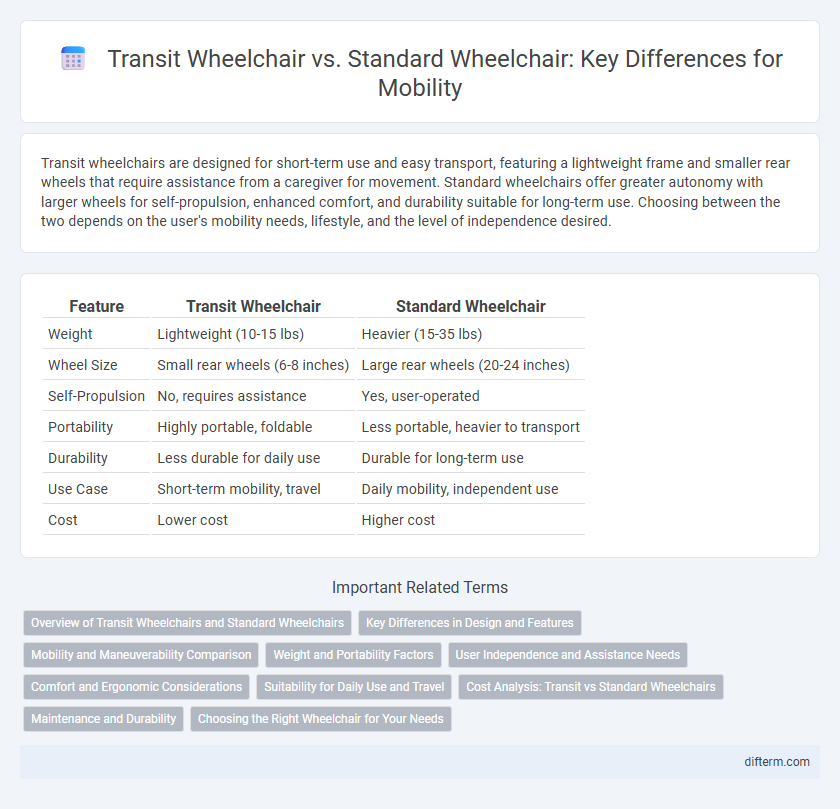Transit wheelchairs are designed for short-term use and easy transport, featuring a lightweight frame and smaller rear wheels that require assistance from a caregiver for movement. Standard wheelchairs offer greater autonomy with larger wheels for self-propulsion, enhanced comfort, and durability suitable for long-term use. Choosing between the two depends on the user's mobility needs, lifestyle, and the level of independence desired.
Table of Comparison
| Feature | Transit Wheelchair | Standard Wheelchair |
|---|---|---|
| Weight | Lightweight (10-15 lbs) | Heavier (15-35 lbs) |
| Wheel Size | Small rear wheels (6-8 inches) | Large rear wheels (20-24 inches) |
| Self-Propulsion | No, requires assistance | Yes, user-operated |
| Portability | Highly portable, foldable | Less portable, heavier to transport |
| Durability | Less durable for daily use | Durable for long-term use |
| Use Case | Short-term mobility, travel | Daily mobility, independent use |
| Cost | Lower cost | Higher cost |
Overview of Transit Wheelchairs and Standard Wheelchairs
Transit wheelchairs are designed primarily for short-term use and transportation, featuring a lightweight frame and smaller rear wheels that require assistance from a caregiver for movement. Standard wheelchairs offer greater independence with larger rear wheels that users can propel themselves, making them suitable for everyday mobility and longer durations. Both types provide essential mobility solutions, but transit wheelchairs prioritize portability and ease of transport while standard wheelchairs emphasize self-mobility and comfort.
Key Differences in Design and Features
Transit wheelchairs are designed with a lightweight frame and four small wheels, optimized for short trips and easy maneuverability in tight spaces, while standard wheelchairs feature larger rear wheels for independent propulsion and longer use. Transit models often prioritize compactness and portability, including features like foldable frames and limited adjustability, whereas standard wheelchairs offer enhanced comfort with customizable seating, better support, and durable construction. The choice depends on user needs for mobility range, control, and transport convenience, with transit wheelchairs favored for caregiver assistance and standard wheelchairs suited for daily independent mobility.
Mobility and Maneuverability Comparison
Transit wheelchairs offer enhanced mobility in tight spaces due to their lightweight frame and compact design, making them ideal for short trips and transport. Standard wheelchairs provide greater maneuverability on uneven terrain and offer more robust support for long-term use or outdoor activities. Comparing their maneuverability, transit wheelchairs excel in portability and ease of navigation in crowded environments, whereas standard wheelchairs deliver stability and comfort for extended mobility needs.
Weight and Portability Factors
Transit wheelchairs typically weigh between 15 to 25 pounds, making them significantly lighter than standard wheelchairs which often exceed 30 pounds. Their compact frames and foldable designs enhance portability, allowing easier transportation in vehicles and storage in small spaces. The lightweight construction of transit wheelchairs improves maneuverability for caregivers without sacrificing basic comfort and support.
User Independence and Assistance Needs
Transit wheelchairs are designed for short-term use and prioritize portability over user independence, often requiring assistance to navigate due to their limited maneuverability and lack of customizable features. Standard wheelchairs provide greater user independence with adjustable components, enhanced comfort, and improved control, allowing users to self-propel and perform daily activities with minimal aid. The choice between transit and standard wheelchairs significantly impacts the level of assistance needed, where transit models are ideal for temporary or caregiver-supported mobility, while standard wheelchairs support long-term, autonomous use.
Comfort and Ergonomic Considerations
Transit wheelchairs are designed for short-term use with lightweight frames, making them less focused on ergonomic support compared to standard wheelchairs. Standard wheelchairs prioritize user comfort through adjustable features such as padded seats, lumbar support, and customizable armrests that enhance posture and reduce pressure points. Ergonomic considerations in standard models improve long-term mobility and reduce fatigue, essential for daily users requiring extended seating periods.
Suitability for Daily Use and Travel
Transit wheelchairs feature lightweight frames and compact designs ideal for short trips and air travel, offering enhanced maneuverability in tight spaces but limited cushioning and adjustability. Standard wheelchairs provide greater comfort and support for daily use with customizable seating and durable construction suited for extended periods of sitting and varied terrains. Choosing between transit and standard wheelchairs depends on individual mobility needs, frequency of travel, and required comfort levels during daily activities.
Cost Analysis: Transit vs Standard Wheelchairs
Transit wheelchairs generally cost between $300 and $700, offering a budget-friendly option designed for short-term use and ease of transportation. Standard wheelchairs, priced from $800 to over $2,500, provide enhanced comfort and durability suitable for daily, long-term mobility needs. Factoring maintenance and replacement parts, transit wheelchairs often incur higher long-term expenses due to less robust construction compared to standard models.
Maintenance and Durability
Transit wheelchairs are engineered for frequent use and often feature lightweight frames with simplified maintenance requirements, making them highly durable under everyday transit conditions. Standard wheelchairs, designed for prolonged use and comfort, typically incorporate more robust components but may require more frequent and detailed maintenance to preserve functionality and safety. Choosing between the two depends on balancing the need for ease of upkeep versus long-term durability in various mobility environments.
Choosing the Right Wheelchair for Your Needs
Transit wheelchairs are lightweight and designed for short-term use, ideal for caregivers to assist with mobility during travel or medical appointments. Standard wheelchairs offer enhanced comfort, durability, and customizable features, making them suitable for long-term use and independent mobility. Selecting the right wheelchair depends on evaluating mobility requirements, frequency of use, and whether the user needs self-propulsion or assistance.
transit wheelchair vs standard wheelchair Infographic

 difterm.com
difterm.com